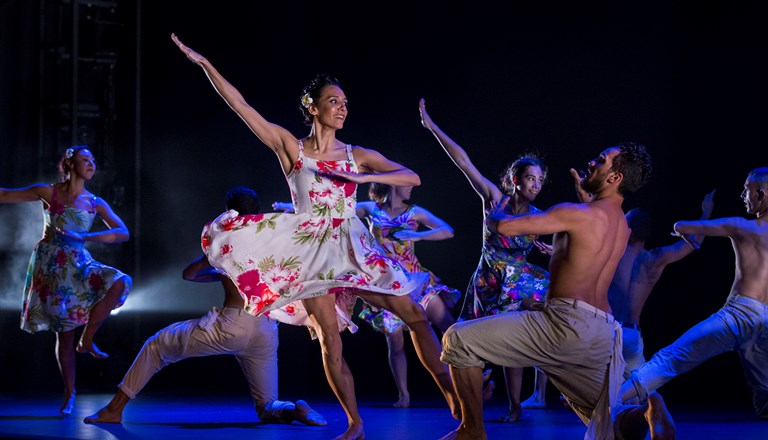I.B.I.S (2015)
Telling the stories: I.B.I.S (2015)
WHAT IS THE INSPIRATION FOR I.B.I.S?
We’re both from Murray Island in the Torres Strait – a beautiful, isolated, sunny, wild land of smiles and loud laughter. We wanted to create a work that puts a smile on the face and gives you an insight into life on the islands – a place where despite challenges of displacement and climate change, the culture remains strong and the people optimistic. — Deborah Brown & Waangenga Blanco, Choreographers, I.B.I.S, 2015
The initial concept for the work I.B.I.S came for Bangarra’s Artistic Director Stephen Page. Stephen invited senior artists, Deborah Brown and Waangenga Blanco to create a new work that focused on Torres Strait Island culture – both traditional and contemporary. They started with the following questions, “What would happen if we highlighted moments that you would see at the store? What happens at the store at night when this frozen aquarium of jellyfish, stingrays and crayfish comes to life? The choreographers used these questions as a starting point for creating the work.
I.B.I.S stands for the Island Board of Industry and Services. IBIS was founded in 1905 and provides goods and services (food and basic commodities) to the inhabitants of the Torres Strait Islands. The company operates 19 stores and 1 service station and is critical to Islander life, providing fresh and preserved food products and essential services, and they also serve as a social gathering place for the community.
For the work I.B.I.S, we’ve created a fictional store where the people are modern day hunters and gathers. The characters portrayed in the work evoke the spirit of the communities of the Torres Strait, their strength, their humour and their very unique way of life. Music, song and dance play a huge role in the lives of the Torres Strait Islanders, providing the means to pass on the knowledge and traditions that keep this community strong.
WHERE DOES THE STORY COME FROM?
There are 274 islands in the Torres Strait, with only 17 of these being inhabited. The islands stretch between the southern part of Papua New Guinea to the tip of Cape York, across an area of 48,000 square kilometres with the Coral Sea to the east and the Arafura Sea to the west.
Torres Strait Islanders are mainly of Melanesian descent, and are distinct from Papua New Guinea and mainland Aboriginal people. Many of the traditional languages are still spoken as well as an English based Creole (‘Broken’). The Islands are often referred to in three groups – Eastern, Central and Western.
It was not until the discovery of large pearl shell fields in 1868, that Europeans established any permanent settlements on the Islands. Christian missionaries soon followed and to a large extent, the Islanders embraced this new belief system and participated in the practices of Christian worship. However, they infused their own songs and music into the Christian services and did not surrender their traditional culture, retaining their songs, music, dance, art and craft, as well as hunting and fishing practices, all of which continue through to today.

